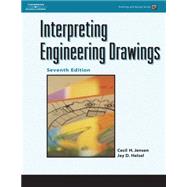
| Bases for Interpreting Engineering Drawings | |
| Engineering Drawings Line Styles and Lettering Sketching Information | |
| Shown on Assignment Drawings | |
| Lines Used to Describe the Shape of a Part Title | |
| Blocks and Title Strips | |
| Drawing to Scale | |
| Circular Features Center Lines | |
| Sketching Circles and Arcs | |
| Working Drawings Arrangement of Views Third-Angle Projection | |
| Sketching Views in Third-Angle | |
| Projection | |
| Dimensioning | |
| Dimensioning Straight-Line Features | |
| Inclined Surfaces Measurement of Angles Symmetrical Outlines | |
| Machine Slots | |
| Pictorial Sketching Isometric | |
| Sketching Oblique Sketching | |
| Machining Symbols Not-To-Scale Dimensions | |
| Drawing Revisions Break Lines | |
| Sectional Views | |
| Types of Sections Countersinks, Counterbores, and Spotfaces | |
| Intersection of Unfinished Surfaces | |
| Chamfers | |
| Undercuts Tapers Knurls | |
| One- and Two-View Drawings | |
| Multiple-Detail Drawings | |
| Functional Drafting | |
| Surface | |
| Texture Surface | |
| Texture Symbol Surface | |
| Texture Ratings | |
| Control Requirements | |
| Tolerances and Allowances | |
| Definitions Tolerancing Methods | |
| Inch Fits Description of Fits Standard Inch Fits | |
| Metric Fits | |
| Threaded Fasteners | |
| Threaded Assemblies | |
| Threaded Holes Inch | |
| Threads Right- and Left-Handed Threads Metric Threads | |
| Revolved and Removed Sections | |
| Keys Set Screws | |
| Flats Bosses and Pads Dimension | |
| Origin Symbol Rectangular Coordinate | |
| Dimensioning Without Dimension Lines Rectangular Coordinate | |
| Dimensioning in Tabular Form | |
| Oblique Surfaces | |
| Primary Auxiliary Views | |
| Secondary Auxiliary Views | |
| Development Drawings Joints, Seams, and Edges Sheet Metal Sizes Stampings | |
| Arrangement of Views | |
| Piping Piping Drawings Pipe Drawing Symbols | |
| Bearings | |
| Manufacturing Materials Cast Iron Steel Plastics Rubber | |
| Casting Processes Casting Design Cored Castings Machining Lugs Surface Coatings | |
| Chain Dimensioning Base Line (Datum) Dimensioning | |
| Alignment of Parts and Holes Partial Views | |
| Naming of Views for Spark Adjuster Drill Sizes | |
| Broken-Out and Partial | |
| Sections Webs in Section Ribs in Section Spokes in Section | |
| Pin Fasteners | |
| Sections Through Shafts, Pins, and Keys | |
| Arrangement of Views of Drawing A-85M | |
| Drawings for Numerical Control | |
| Dimensioning for Numerical Control | |
| Dimensioning for Two-Axis Coordinate System | |
| Assembly Drawings Bill of Material (Item List) Helical Springs | |
| Structural Steel Shapes Phantom Outlines Conical Washers | |
| Welding Drawings Welding Symbols Fillet Welds | |
| Groove Welds Supplementary Symbols | |
| Other Basic Welds Plug and Slot Welds | |
| Gears, Spur Gears | |
| Bevel Gears | |
| Gear Trains | |
| Cams | |
| Antifriction Bearings Retaining | |
| Rings O-Ring Seals Clutches | |
| Belt Drives | |
| Ratchet Wheels | |
| Modern Engineering Tolerancing | |
| Geometric Tolerancing | |
| Feature Control Frame Form Tolerances | |
| Straightness | |
| Straightness of a Feature Size | |
| Feature of Size Definitions Material Condition Symbols Maximum | |
| Material Condition (MMC) | |
| Regardless of Feature Size (RFS) | |
| Least Material Condition (LMC) | |
| Straightness of a Feature of Size | |
| Form Tolerances Flatness | |
| Circularity Cylindricity | |
| Datums and the Three-Plane Concept Datums for Geometric Tolerancing | |
| Three-Plane System Uneven Surfaces Datum | |
| Feature Symbol | |
| Orientation Tolerances | |
| Orientation Tolerancing for Flat Surfaces | |
| Orientation Tolerancing for Features of Size Internal | |
| Cylindrical Features | |
| External Cylindrical Features | |
| Datum Targets | |
| Tolerancing of Features by Position Tolerancing Methods Coordinate | |
| Tolerancing Advantages of Coordinate Tolerancing | |
| Disadvantages of Coordinate | |
| Tolerancing Positional | |
| Tolerancing Material Condition Basis Positional | |
| Tolerancing for Circular Features | |
| Advantages of Positional Tolerancing | |
| Selection of Datum | |
| Features for Positional Tolerancing | |
| Profile Tolerances Profile of a | |
| Table of Contents provided by Publisher. All Rights Reserved. |
The New copy of this book will include any supplemental materials advertised. Please check the title of the book to determine if it should include any access cards, study guides, lab manuals, CDs, etc.
The Used, Rental and eBook copies of this book are not guaranteed to include any supplemental materials. Typically, only the book itself is included. This is true even if the title states it includes any access cards, study guides, lab manuals, CDs, etc.